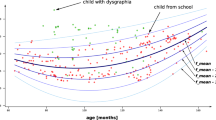Abstract
To date, clinical assessment remains the gold standard in the diagnosis of Parkinson’s disease (PD). We sought to identify simple characteristics of handwriting which could accurately differentiate PD patients from healthy controls. Twenty PD patients and 20 matched controls wrote their name and copied an address on a paper affixed to a digitizer. Mean pressure and mean velocity was measured for the entire task and the spatial and temporal characteristics were measured for each stroke. Results of the MANOVAs for the temporal, spatial, and pressure measures (stroke length, width, and height; mean pressure; mean time per stroke; mean velocity), for both the name writing and address copying tasks, showed significant group effects (F(6,32) = 6.72, p < 0.001; F(6,31) = 14.77, p < 0.001, respectively). A discriminant analysis was performed for the two tasks. One discriminant function was found for the group classification of all participants (Wilks’ Lambda = 0.305, p < 0.001). Based on this function, 97.5 % of participants were correctly classified (100 % of the controls and 95 % of PD patients). A Kappa value of 0.947 (p < 0.001) was calculated, demonstrating that the group classification did not occur by chance. In this pilot study we identified two simple short and routine writing tasks which differentiate PD patients from healthy controls. These writing tasks have future potential as cost-effective, fast and reliable biomarkers for PD.
Similar content being viewed by others
References
Marek K, Jennings D, Lasch S (2011) The Parkinson progression marker Initiative (PPMI). Prog Neurobiol 95:629–663
Ravina B, Tanner C, Dieuliis D, Eberly S, Flagg E, Galpern WR, Fahn S, Goetz CG, Grate S, Kurlan R, Lang AE, Marek K, Kieburtz K, Oakes D, Elliott R, Shoulson I; Parkinson Study Group LABS-PD Investigators (2009) A longitudinal program for biomarker development in Parkinson’s disease: a feasibility study. Mov Disord 24:2081–2090
Tisch U, Schlesinger I, Ionescu R, Nassar M, Axelrod N, Robertman D, Tessler Y, Azar F, Marmur A, Aharon-Peretz J, Haick H (2013) Detection of Alzheimer’s and Parkinson’s disease from exhaled breath using nanomaterial-based sensors. Nanomedicine (Lond) 8:43–56
Wu Y, Le W, Jankovic J (2011) Preclinical biomarkers of Parkinson disease. Arch Neurol 68:22–30
Chahine LM, Stern MB (2011) Diagnostic markers for Parkinson’s disease. Curr Opin Neurol 24:309–317
de la Fuente-Fernández R (2012) Role of DaTSCAN and clinical diagnosis in Parkinson disease. Neurology 78:696–701
Carmeli E, Patish H, Colman R (2003) The aging hand. J Gerontol A Biol Sci Med Sci 58:146–152
Horowski R, Horowski L, Vogel S, Poewe W, Kielhorn FW (1995) An essay on Wilhelm von Humboldt and the shaking palsy: first comprehensive description of Parkinson’s disease by a patient. Neurology 45:565–568
Eichhorn TE, Gasser T, Mai N, Marquardt C, Arnold G, Schwarz J, Oertel WH (1996) Computational analysis of open loop handwriting movements in Parkinson’s disease: a rapid method to detect dopamimetic effects. Mov Disord 11:289–297
Poluha PC, Teulings HL, Brookshire RH (1998) Handwriting and speech changes across the levodopa cycle in Parkinson’s disease. Acta psycho (Amst) 100:71–84
Teulings HL, Contreras-Vidal JL, Stelmach GE, Adler CH (2002) Adaptation of handwriting size under distorted visual feedback in patients with Parkinson’s disease and elderly and young controls. J Neurol Neurosurg Psychiatry 72:315–324
Tucha O, Mecklinger L, Thome J, Reiter A, Alders GL, Sartor H, Naumann M, Lange KW (2006) Kinematic analysis of dopaminergic effects on skilled handwriting movements in Parkinson’s disease. J Neural Transm 113:609–623
Oliveira RM, Gurd JM, Nixon P, Marshall JC, Passingham RE (1997) Micrographia in Parkinson’s disease: the effect of providing external cues. J Neurol Neurosurg Psychiatry 63:429–433
Ondo WG, Satija P (2007) Withdrawal of visual feedback improves micrographia in Parkinson’s disease. Mov Disord 22:2130–2131
Gibb WR, Lees AJ (1988) The relevance of the Lewy body to the pathogenesis of idiopathic Parkinson’s disease. J Neurol Neurosurg Psychiatry 51:745–752
Hoehn MM, Yahr MD (1967) Parkinsonism: onset, progression and mortality. Neurology 17:427–442
Folstein MF, Folstein SE, McHugh PR (1975) “Mini-mental state”: a practical method for grading the cognitive state of patients for the clinician. J Psychiatr Res 12:189–198
Rosenblum S, Parush S, Weiss PL (2003) Computerized temporal handwriting characteristics of proficient and non-proficient handwriters. Am J Occup Ther 57:129–138
Becker G, Müller A, Braune S, Büttner T, Benecke R, Greulich W, Klein W, Mark G, Rieke J, Thümler R (2002) Early diagnosis of Parkinson’s disease. J Neurol 249(Suppl 3:III):40–48
Rosenblum S, Dvorkin A, Weiss PL (2006) Automatic segmentation as a tool for examining the handwriting process of children with dysgraphic and proficient handwriting. Hum Mov Sci 25:608–621
Werner P, Rosenblum S, Bar-On G, Heinik J, Korczyn A (2006) Handwriting process variables discriminating mild Alzheimer’s disease and mild cognitive impairment. J Gerontol B Psychol Sci Soc Sci 61:228–236
Sesa-Nogueras E, Faundez-Zanuy M, Mekyska J (2012) An Information Analysis of In-Air and On-Surface Trajectoriesin Online Handwriting. Cogn Comput 4:195–205
McLennan JE, Nakano K, Taylor HR, Schwab RS (1972) Micrographia in Parkinson’s disease. J Neurol Sci 15:141–152
Hatzitaki V, Hoshizaki TB (1998) Dynamic joint analysis as a method to document coordination disabilities associated with Parkinson’s disease. Clin Biomech 13:182–189
Conflicts of interest
The authors declare no disclosures.
Author information
Authors and Affiliations
Corresponding author
Additional information
The statistical analysis was performed by Sara Rosenblum from the Department of Occupational Therapy, Faculty of Social Welfare and Health Sciences University of Haifa, Israel.
Rights and permissions
About this article
Cite this article
Rosenblum, S., Samuel, M., Zlotnik, S. et al. Handwriting as an objective tool for Parkinson’s disease diagnosis. J Neurol 260, 2357–2361 (2013). https://doi.org/10.1007/s00415-013-6996-x
Received:
Revised:
Accepted:
Published:
Issue Date:
DOI: https://doi.org/10.1007/s00415-013-6996-x




